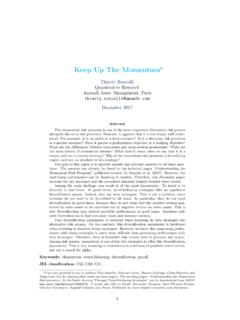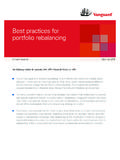Transcription of Long-term investment, the cost of capital and the dividend ...
1 OECD Journal: Financial Market Trends Volume 2013 Issue 1 Pre-print version OECD 2013 Long-term investment , the cost of capital and the dividend and buyback puzzle by Adrian Blundell-Wignall and Caroline Roulet * The paper argues that interest rates are at extremely low levels to support banks, and the search for yield has pushed the liquidity driven speculative bubble from real estate, derivatives and structured products markets into the corporate debt market. Equities have rallied strongly too. This asset cycle is certainly helping banks reduce hidden losses on illiquid securities and could also help reduce the cost of equity.
2 But for this to occur at current bond yields would require an unrealistic bubble in equities. Markets are assuming that this transition from low to higher rates (more in line with nominal GDP) can be handled smoothly by policy makers, when in fact this may not be so. Extreme volatility would risk new financial fragility problems. The paper presents a panel model using more than 4,000 global companies and shows that the Capex decision in general depend on the cost of equity, the accelerator and uncertainty, whereas buybacks are driven mainly by the gap between the cost of equity and debt.
3 Right now the incentive structure implied by very low interest rates, which may be sustained for a long time, together with tax incentives, works directly against Long-term investment . Debt finance is cheap, while the cost of equity capital needed for risky Long-term investment is still high. This combination provides a direct incentive for borrowing to carry out buybacks (de-equitisation). Noting that weak investment reduces potential GDP, the paper makes some policy suggestions. JEL Classification: G15, G32, G28, E52.
4 Keywords: Long-term investment , interest rates, de-equitisation, cost of capital , dividend and buybacks, monetary policy. * Adrian Blundell-Wignall is the Special Advisor to the OECD Secretary-General for Financial Markets, and the Deputy Director of the Directorate of Financial and Enterprise Affairs ( ). Caroline Roulet is an OECD economist and analyst. The views in this paper are those of the authors, and do not necessarily reflect those of any member government of the OECD. Long-term investment , THE cost OF capital AND THE dividend AND BUYBACK PUZZLE 2 OECD JOURNAL: FINANCIAL MARKET TRENDS 2013/1 OECD 2013 I.
5 Introduction The US Federal Reserve, the ECB, and the Bank of England have conducted a policy of low rates and/or unconventional policies of buying out along the yield curve to reduce the term premium. Most recently, announcements from the Bank of Japan suggest that they too will follow suit, and this has seen a sharp fall in the yen. A weakening yen, and a rising risk appetite for yield in Asia, also risks seeing quantitative easing spread beyond OECD economies to Asia. These policies are expressly designed to help banks recover and deal with bad loans and to help the economy by encouraging risk taking: to increase the relative attractiveness of corporate debt and equities, both of which may be used to finance Long-term investment .
6 Portfolio investors have indeed taken more risk, forced out of low-yield low-risk assets in the search for higher yields in equities and corporate bond markets. This has led to an extraordinary rally in higher yielding corporate bonds, and the equity market too has rallied strongly. But so far this increased portfolio risk taking has not translated into a surge of capital spending at the company level. The US economy is picking up only moderately, and unemployment remains stuck at high levels. The traditional job-producing cycle that is created by new net investment has not materialised as in past cycles.
7 In Europe, the recession seems to have gathered pace in early 2013, banks continue to cut lending and there is certainly no sign of any pick-up in business investment . At the same time corporate borrowing has been strong, equity issuance weak, and companies have frequently decided to return cash flow to shareholders in the form of dividends and buybacks. The aim of this study is to explore this puzzle in more detail. It does so by using microeconomic data on cash flow, capital expenditure, dividends, and buyback decisions of thousands of observations from non-financial companies included in the MSCI global stock index.
8 Section II looks at some of the macroeconomic indicators of the distortionary responses to the financial crisis that may be distorting investment decisions. Section III then looks at some of the microeconomic characteristics of the data and the capital expenditure, dividend and buyback outcomes. It hypothesises that the high level of uncertainty, the low cost of corporate debt and the high cost of equity funding is favouring dividends and buybacks at the expense of investment . Panel regression techniques are then used to explore whether this hypothesis is supported by the data in section IV.
9 Finally, some concluding remarks are made in section V on the likely causes of the failure of policy to translate into better economic performance, and what areas policy makers might look to improve this situation. II. Macroeconomic Influences on the investment Incentives The effect of unconventional monetary policy, including the compression of term premium and risk premiums by buying out along the curve is shown for the United States in Figure 1. The search for yield on the part of investors has led to a rally in non-Government paper, as the risk free sovereign yield has declined to record low levels (the USA 10-year bond rate is below 2% in early April 2013).
10 While the financial crisis began with excess leverage on the part of banks and households, currently being unwound in a massive deleveraging, that bubble is being transferred to the securities markets and the corporate sector, which is now issuing debt to lock-in low rates. In Asia as well, corporate issuance is in a bubble phase, with many low quality and even unrated issues being many time Long-term investment , THE cost OF capital AND THE dividend AND BUYBACK PUZZLE OECD JOURNAL: FINANCIAL MARKET TRENDS 2013/1 OECD 2013 3 Extreme low interest rates do not provide an incentive to invest2 With respect to bond financing, the interest rate on corporate debt ( i ) must be consistent with the bond investor s required return ( r ) given the personal tax rate ( t ).

















